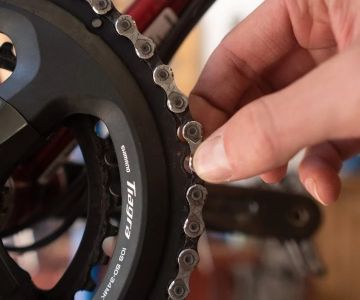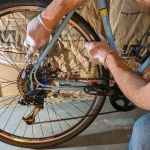
- The Importance of Proper Tire Pressure
- Gravel vs Pavement: How Terrain Affects Tire Pressure
- Optimal Tire Pressure for Gravel Riding
- Optimal Tire Pressure for Pavement Riding
- How to Adjust Tire Pressure for Different Conditions
- Real-Life Case Study: Choosing the Right Tire Pressure for Different Terrains
- Where to Find the Best Tires for Gravel and Pavement
The Importance of Proper Tire Pressure
Proper tire pressure is one of the most critical factors affecting your cycling performance, comfort, and safety. Whether you're riding on gravel or pavement, the right tire pressure ensures optimal contact with the road or trail, improves traction, and helps prevent tire wear. Too much pressure can lead to a harsh ride and reduced grip, while too little pressure can cause excessive rolling resistance and a higher risk of flats.
Knowing the ideal tire pressure for different terrains, such as gravel and pavement, can help you get the most out of your cycling experience. Understanding the unique demands of these surfaces and adjusting your tire pressure accordingly is crucial for both performance and durability.
Gravel vs Pavement: How Terrain Affects Tire Pressure
Gravel and pavement are vastly different surfaces, each requiring different tire pressure to optimize performance and comfort. Here’s how the terrain affects your tire pressure choice:
Gravel Terrain
Gravel surfaces are uneven and often rough, with varying levels of firmness. This makes it essential to have tires with a lower pressure to absorb shocks and maintain better traction. Lower pressure allows the tire to conform to the terrain, providing a smoother and more controlled ride, especially over loose or rocky surfaces. It also reduces the chances of punctures and improves grip on softer surfaces.
Pavement Terrain
Pavement is much smoother and more predictable, which means higher tire pressure is more beneficial. High pressure reduces rolling resistance, making your bike faster and more efficient on hard surfaces. The higher pressure also maintains a firm, stable contact with the road, providing better handling and responsiveness.
Optimal Tire Pressure for Gravel Riding
When riding on gravel, the optimal tire pressure will depend on your bike type, the weight you're carrying, and the specific conditions of the trail. For most gravel bikes, a range of 35 to 50 PSI (pounds per square inch) is generally ideal. However, the following factors may influence the exact pressure you should choose:
- Bike Type: A gravel bike typically uses wider tires that benefit from slightly lower pressure. For wider tires (38mm and above), start with around 40-45 PSI.
- Weight: Heavier riders may require slightly higher pressure to avoid bottoming out, while lighter riders can usually go lower for more comfort.
- Terrain Type: If you're riding on loose, sandy gravel or soft trails, opt for lower pressure (around 35-40 PSI) to enhance grip and comfort. For firmer gravel or packed trails, you can increase the pressure slightly for more efficiency.
Optimal Tire Pressure for Pavement Riding
On smooth pavement, tire pressure should be higher to reduce rolling resistance and increase speed. For road bikes, a pressure range of 80 to 120 PSI is typically recommended, but it can vary based on your tire width, riding style, and personal comfort preferences:
- Road Bikes: For tires that are 23mm to 28mm wide, start with around 90-100 PSI. For wider tires, such as 32mm or 35mm, you can lower the pressure to around 80-85 PSI.
- Comfort and Touring Bikes: If you're riding a comfort or touring bike, you may prefer lower pressures around 70-80 PSI to ensure a smooth and cushioned ride, especially if you're carrying extra gear.
It's important to adjust the pressure based on factors like road quality and personal comfort. If you notice excessive vibrations or feel sluggish, try adjusting your tire pressure to find the sweet spot between comfort and speed.
How to Adjust Tire Pressure for Different Conditions
Changing tire pressure for different riding conditions can be a simple yet effective way to improve your cycling experience. Here’s how to adjust your tire pressure based on various conditions:
- Before Every Ride: Check your tire pressure before every ride to ensure it’s within the ideal range. Over time, tires naturally lose air, so regular maintenance is key to performance.
- Adjusting for Weather Conditions: During wet or rainy weather, lower your tire pressure slightly to increase grip on slippery surfaces. On dry, hard-packed gravel, you may want to increase the pressure for more speed.
- Heavy Loads: If you're carrying gear or riding with a heavy load, increase the tire pressure slightly to support the added weight and avoid pinch flats.
Real-Life Case Study: Choosing the Right Tire Pressure for Different Terrains
Take the example of Sarah, an avid cyclist who enjoys both gravel trail rides and long road bike commutes. Sarah used to use the same tire pressure for both terrains, but found that her gravel rides were uncomfortable, and her road bike rides felt sluggish.
After learning about the different tire pressure needs for gravel and pavement, she decided to experiment with adjusting her tire pressure. For her gravel rides, she dropped the pressure to around 40 PSI, which gave her better traction and comfort over the uneven surfaces. On her road bike, she increased the pressure to 100 PSI, which made her rides smoother and faster on the pavement.
Sarah’s experience highlights the importance of adjusting tire pressure based on terrain to enhance both comfort and performance. By tailoring her tire pressure to the specific conditions, she significantly improved her riding experience.
Where to Find the Best Tires for Gravel and Pavement
Choosing the right tires for your bike is essential for optimizing your riding experience. At Cycling Guider, we offer a wide range of tires suitable for both gravel and pavement riding. Whether you're looking for durable gravel tires or high-performance road bike tires, we have the perfect options for you.
Visit Cycling Guider to find the best tires and products to enhance your cycling performance and comfort.







 Wheel & Sprocket4.0 (586 reviews)
Wheel & Sprocket4.0 (586 reviews) Norco Cycle4.0 (71 reviews)
Norco Cycle4.0 (71 reviews) Seagreen Bicycle4.0 (225 reviews)
Seagreen Bicycle4.0 (225 reviews) Huntington Beach Bicycle Co.4.0 (40 reviews)
Huntington Beach Bicycle Co.4.0 (40 reviews) Rubber Soul Bicycles4.0 (215 reviews)
Rubber Soul Bicycles4.0 (215 reviews) Cynergy E-Bikes4.0 (235 reviews)
Cynergy E-Bikes4.0 (235 reviews) How to Teach Kids to Ride a Bike: A Step-by-Step Guide for Parents
How to Teach Kids to Ride a Bike: A Step-by-Step Guide for Parents Tips for Riding on Busy City Streets: Smart Strategies for Urban Cyclists
Tips for Riding on Busy City Streets: Smart Strategies for Urban Cyclists Best US National Parks for Mountain Biking: Ride Epic Trails Across America
Best US National Parks for Mountain Biking: Ride Epic Trails Across America Best Aero Helmets for Time Trials and Racing
Best Aero Helmets for Time Trials and Racing How to Clean and Lubricate Your Bike Chain Like a Pro
How to Clean and Lubricate Your Bike Chain Like a Pro 10 Must-Have Items for Long-Distance Cycling Trips
10 Must-Have Items for Long-Distance Cycling Trips